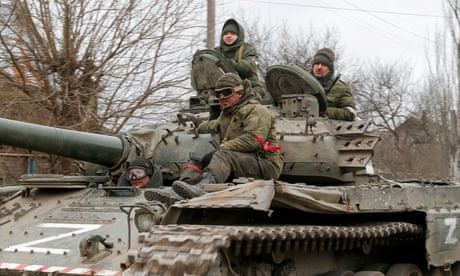- by foxnews
- 11 Jan 2025
Friendly fire blunders, confusion, low morale: why Russia’s army has stalled
Friendly fire blunders, confusion, low morale: why Russia’s army has stalled
- by theguardian
- 03 Apr 2022
- in news

Uniforms are one of the most deceptive trappings of military culture. They suggest uniformity but it is often said of the British army that if two officers look the same, one must be improperly dressed. Armies, and especially professional armies, are more often warring tribes of subcultures, and for commanders it is critical to understand how those cultures interact if the force is to be employed effectively in battle.
When it comes to Russian military culture, the Russian army has been through a period of significant change, with constant modernisation since 2008. The Soviet Union fielded an army of more than 3.5 million soldiers in 1991. The Soviet army was largely a conscript force and lacked an experienced noncommissioned officer corps. This meant that Soviet units had to be treated with a degree of uniformity, since the personnel rotated so frequently that most line units were necessarily commanded using set formulas that formed the basis for unit training.
Today's Russian military is much smaller with about 1 million personnel across all services. For the army, conscripts today make up only about 35% of the force. The high proportion of contract soldiers should produce a more distinct unit culture. This is reinforced by how units have been fighting. Among Russia's higher-readiness forces, the wars in Ukraine and Syria have seen fighting being conducted primarily at the level of the company group, producing units with contract troops who have fought together, but rarely in large formations.
This process of experience being concentrated into small units of action has been further accelerated by the expansion of Russian special purpose units. FSB (security service) units have for a long time been focused on repressive counter-terrorism alongside Chechen troops, who are well equipped but largely lack experience of heavy fighting. GU and KSO "special purpose troops", meanwhile, have tended to operate in small teams - sometimes down to pairs - behind enemy lines. Although the Russian officer corps has been rotated through Donbas and Syria, the scale of activity they managed there has been limited.
As well as disparities in experience between Russian military units, there is also the different geographic focus of various formations. Russia spans 11 time zones, and consequently its military districts are confronted with very different problems. The Western Military District was positioned to confront Nato. The Southern Military District was set up for expeditionary operations. The Northern Military District is responsible for the high north, and the Eastern Military District guards Vladivostok and the Chinese border. Because formations in these regions are aligned to a variety of threats, they receive different equipment, with the eastern district usually the last to get upgraded vehicles and gear.
The challenge that Russia has struggled to address is that while its force has become increasingly fragmented into units where experience is largely confined to company-sized or at most battalion-sized actions, Russia's political aspirations have far exceeded the capacity of these formations. Battalion tactical groups operating under independent brigades, for example, proved logistically inadequate in 2015, leading to the reintroduction of divisions to manage supply.
Preparing for the war in Ukraine, Russia has drawn troops from across its military districts, fielding 190,000 personnel from units that have rarely worked together and that use a wide range of equipment of varying vintage.
Further complexity emerges from the mobilisation of raw recruits from the occupied Luhansk and Donetsk enclaves, the deployment of interior riot police and Rosgvardia (national guard) troops, meant for crowd control rather than warfighting, and Wagner mercenaries. Some Rosgvardia personnel have refused to deploy to Ukraine. Wagner include some experienced soldiers, though their track record in offensive operations is poor. They have also not previously participated in large-scale Russian military exercises, making it ambiguous how they are to be commanded in the field.
Planning to deploy such a diverse force would usually require careful consideration as to how units with different equipment, experience, culture and training levels would interact and complement one another. The sequencing of which units would attack first would be carefully worked out. Instead, these units have largely been committed piecemeal, using the same roads, with limited efforts to establish effective control measures or assign battlespace. Although units were given markings to indicate their axis of advance, many formations have become intermingled, causing friendly fire incidents and confusion, and cratering morale.
Slowly, Russian senior officers have begun to impose order on operations, but with too many troops pushed forward, too few reserves and insufficient logistical support, they are paying a heavy price for early blunders. In many respects, the Russian military has been caught between its political aspirations to fight large wars, and the experience of its soldiers, which has been confined to small ones.
- by foxnews
- descember 09, 2016
TSA reveals top unusual finds at airport security checkpoints in 2024
The Transportation Security Administration released the "top catches" from 2024 with prohibited items found by agents across the country. See some tips for travelers.
read more


